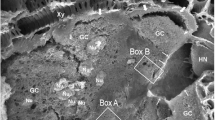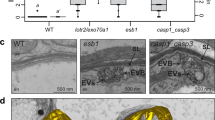Summary
Light microscopic observations dating back to 1892 have established that sieve elements of papilionaceous legumes contain a unique type of slime body. This large, compact crystalline type of P-protein has also been observed in sieve elements in recent electron microscopic investigations but its formation and possible relationship to other P-protein structures have not been examined. The present fine structural study describes its development in hypocotyl tissue of 4-day old seedlings of soybean (Glycine max L.). Preceding the formation of a P-protein body, a young sieve element possesses large numbers of ribosomes, abundant vesiculate ER and numerous dictyosomes surrounded by vesicles. A finely granular material accumulates among these components, then condenses into electron opaque masses. Scattered bundles of tubules appear within these masses, then aggregate, and next align longitudinally in the sieve element. By a further transformation, the tubules are converted into an electron opaque crystalline P-protein body. This body continues to grow by aggregation and transformation of additional tubules, and at maturity may be as long as 15–30 microns. The main body, which is square in cross section, tapers toward the ends and is terminated by sinuous “tails”. Eventually this crystal disperses into a mass of fine striated fibers that fills the lumen of the mature sieve element. Attention is directed to similarities between the bundles of tubules and previously described “extruded nucleoli”. Factors possibly involved in the structural variations and transformations described above are also discussed.
Similar content being viewed by others
References
Baccarini, P., 1892: Intorno ad una particalarità dei vasi cribrosi nellePapilionaceae. Malpighia6, 53–57.
Behnke, H.-D., 1969: Über den Feinbau und die Ausbreitung der Siebröhren-Plasmafilamente und über Bau und Differenzierung der Siebporen bei einigen Monocotylen und beiNuphar. Protoplasma68, 377–402.
Bouck, G. B., andJ. Cronshaw, 1965: The fine structure of differentiating sieve tube elements. J. Cell Biol.25, 79–96.
Buvat, R., 1963: Sur la présence d'acide ribonucléique dans les « corpuscules muqueux » des cellules criblées deCucurbita pepo. C. R. Acad. Sci.257, 733–735.
Caro, L. G., andG. E. Palade, 1964: Protein synthesis, storage, and discharge in the pancreatic exocrine cell. An autoradiographic study. J. Cell Biol.20, 473–496.
Caspar, D. L. D., 1964: Design and assembly of organized biological structures. In: Molecular architecture in cell physiology (T. Hayashi andA. G. Szent-Győrgi, eds.), p. 191–207. Englewood Cliffs, New Jersey: Prentice-Hall, Inc.
—, 1965: Design principles in biological organization. In: Principles of biomolecular organization (G. E. W. Wolstenholme andM. O'Conner, eds.), p. 7–39. Boston: Little, Brown and Co.
Cronshaw, J., andK. Esau, 1967: Tubular and fibrillar components of mature and differentiating sieve elements. J. Cell Biol.34, 801–816.
Cronshaw, J., andK. Esau, 1968a: P-protein in the phloem ofCucurbita. I. The development of P-protein bodies. J. Cell Biol.38, 25–39.
— —, 1968b: P-protein in the phloem ofCucurbita. II. The P-protein of mature sieve elements. J. Cell Biol.38, 292–303.
Deshpande, B. P., and R. F.Evert, 1970: A reevaluation of extruded nucleoli in sieve elements. J. Ultrastruct. Res. In press.
Esau, K., andJ. Cronshaw, 1967: Tubular components in cells of healthy and tobacco mosaic virus-infectedNicotiana. Virology33, 26–35.
—, andR. H. Gill, 1970: Observations on spiny vesicles and P-protein inNicotiana tabacum. Protoplasma69, 373–388.
Evert, R. F., andB. P. Deshpande, 1969: Electron microscope investigation of sieve-element ontogeny and structure inUlmus americana. Protoplasma68, 403–432.
— —, 1970: Nuclear P-protein in sieve elements ofTilia americana. J. Cell Biol.44, 462–466.
—, andL. Murmanis, 1965: Ultrastructure of the secondary phloem ofTilia americana. Amer. J. Bot.52, 95–106.
Gerola, F. M., G. Lombardo, andA. Catara, 1969: Histological localization of citrus infectious variegation virus (CVV) inPhaseolus vulgaris. Protoplasma67, 319–326.
Inoué, S., 1964: Organization and function of the mitotic spindle. In: Primitive motile systems in cell biology (R. D. Allen andN. Kamiya, eds.), p. 549–598. New York: Academic Press.
Kiselev, N. A., C. L. Shpitzberg, andB. K. Vainshtein, 1967: Crystallization of catalase in the form of tubes with monomolecular walls. J. molec. Biol.25, 433–441.
Kollmann, R., 1960: Untersuchungen über das Protoplasma der Siebröhren vonPassiflora coerulea. II. Elektronenoptische Untersuchungen. Planta (Berl.)55, 67–107.
Kushner, D. J., 1969: Self-assembly of biological structures. Bact. Rev.33, 302–345.
Laflèche, D., 1966: Ultrastructure et cytochimie des inclusions flagellées des cellules criblées dePhaseolus vulgaris L. J. Microscopie5, 493–510.
Marsland, D., andA. M. Zimmerman, 1965: Structural stabilization of the mitotic apparatus by heavy water, in the cleaving eggs ofArbacia punctulata. Exp. Cell Res.38, 306–313.
Mishra, U., andD. C. Spanner, 1970: The fine structure of the sieve tubes ofSalix caprea L. and its relation to the electroosmotic theory. Planta (Berl.)90, 43–56.
Newcomb, E. H., 1967: A spiny vesicle in slime-producing cells of the bean root. J. Cell Biol.35, C17-C22.
Northcote, D. H., andF. B. P. Wooding, 1966: Development of sieve tubes inAcer pseudoplatanus. Proc. roy. Soc. B.163, 524–537.
— —, 1968: The structure and function of phloem tissue. Sci. Prog. Oxf.56, 35–58.
Parthasarathy, M. V., andK. Mühlethaler, 1969: Ultrastructure of protein tubules in differentiating sieve elements. Cytobiologie1, 17–36.
Schmitt, F. O., 1968: Giant molecules in cells and tissues. In: The molecular basis of life, p. 16–23. San Francisco: W. H. Freeman and Co.
Steer, M. W., andE. H. Newcomb, 1969: Development and dispersal of P-protein in the phloem ofColeus blumei Benth. J. Cell Biol.4, 155–169.
Strasburger, E., 1891: Über den Bau und die Verrichtungen der Leitungsbahnen in den Pflanzen. Histologische Beiträge. Heft III. 1000 p. Jena: Gustav Fischer.
Tamulevich, S. R., andR. F. Evert, 1966: Aspects of sieve element ultrastructure inPrimula obconica. Planta (Berl.)69, 319–337.
Wark, M. C., andT. C. Chambers, 1965: I. The sieve element ontogeny. Aust. J. Bot.13, 171–183.
Wergin, W. P., P. J. Gruber, andE. H. Newcomb, 1970: Fine structural investigation of nuclear inclusions in plants. J. Ultrastruct. Res.30, 533–557.
Wooding, F. B. P., 1967: Fine structure and development of phloem sieve tube content. Protoplasma64, 315–324.
—, 1969: P-protein and microtubular systems inNicotiana callus phloem. Planta (Berl.)85, 284–298.
Zee, S.-Y., 1968: Ontogeny of cambium and phloem in the epicotyl ofPisum sativum. Aust. J. Bot.16, 419–426.
—, 1969a: Fine structure of the differentiating sieve elements ofVicia faba. Aust. J. Bot.17, 441–456.
—, 1969b: P-protein producing cells of the primary root ofVicia faba. Aust. J. biol. Sci.22, 1573–1576.
—, 1969c: The developmental fate of endoplasmic reticulum in the sieve element ofPisum, Aust. J. biol. Sci.22, 257–259.
Author information
Authors and Affiliations
Additional information
This work was supported in part by grant no. GB-15246 from the National Science Foundation.
Rights and permissions
About this article
Cite this article
Wergin, W.P., Newcomb, E.H. Formation and dispersal of crystalline P-protein in sieve elements of soybean (Glycine max L.). Protoplasma 71, 365–388 (1970). https://doi.org/10.1007/BF01279682
Received:
Issue Date:
DOI: https://doi.org/10.1007/BF01279682




